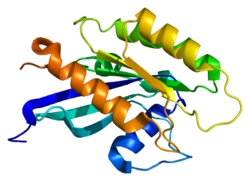
Tuftelin is an acidic phosphorylated glycoprotein found in tooth enamel. In humans, the Tuftelin protein is encoded by the TUFT1 gene. It is an acidic protein that is thought to play a role in dental enamel mineralization and is implicated in caries susceptibility. It is also thought to be involved with adaptation to hypoxia, mesenchymal stem cell function, and neurotrophin nerve growth factor mediated neuronal differentiation.

Flotillin-1 is a protein that in humans is encoded by the FLOT1 gene.

Mannose-6-phosphate receptor binding protein 1 (M6PRBP1) is a protein which in humans is encoded by the M6PRBP1 gene. Its gene product, as well as the gene itself, is commonly known as TIP47.

Calumenin is a protein that in humans is encoded by the CALU gene.

Nucleolar complex protein 2 homolog is a protein that in humans is encoded by the NOC2L gene.

Sterol-4-alpha-carboxylate 3-dehydrogenase, decarboxylating is an enzyme that in humans is encoded by the NSDHL gene. This enzyme is localized in the endoplasmic reticulum and is involved in cholesterol biosynthesis.

Alpha-taxilin also known as interleukin-14 (IL-14) or high molecular weight B-cell growth factor (HMW-BCGF) is a protein that in humans is encoded by the TXLNA gene.

Golgin subfamily A member 3 is a protein that in humans is encoded by the GOLGA3 gene.

40S ribosomal protein S14 is a protein that in humans is encoded by the RPS14 gene.

Tuftelin-interacting protein 11 is a protein that in humans is encoded by the TFIP11 gene.

Oxysterol-binding protein-related protein 5 is a protein that in humans is encoded by the OSBPL5 gene.

Butyrophilin subfamily 1 member A1 is a protein that in humans is encoded by the BTN1A1 gene.

Serine/threonine-protein kinase PCTAIRE-3 is an enzyme that in humans is encoded by the PCTK3 gene.

Scinderin is a protein that in humans is encoded by the SCIN gene. Scinderin is an actin severing protein belonging to the gelsolin superfamily. It was discovered in Dr. Trifaro's laboratory at the University of Ottawa, Canada. Secretory tissues are rich in scinderin. In these tissues scinderin, a calcium dependent protein, regulates cortical actin networks. Normally secretory vesicles are excluded from release sites on the plasma membrane by the presence of a cortical actin filament network. During cell stimulation, calcium channels open allowing calcium ions to enter the secretory cell. Increase in intracellular calcium activates scinderin with the consequent actin filament severing and local dissociation of actin filament networks. This allows the movement of secretory vesicles to release sites on the plasma membrane.

CD320 is a human gene.

Cysteine-rich secretory protein LCCL domain-containing 2 is a cysteine-rich secretory protein that in humans is encoded by the CRISPLD2 gene.

CDK12 cyclin-dependent kinase 12 is a protein kinase that in humans is encoded by the CDK12 gene. This enzyme is a member of cyclin-dependent kinase protein family.

Transmembrane protein 49 is a protein that in humans is encoded by the TMEM49 gene.

A disintegrin and metalloproteinase with thrombospondin motifs 12 is an enzyme that in humans is encoded by the ADAMTS12 gene.

Centrosomal protein of 135 kDa is a protein that in humans is encoded by the CEP135 gene. It is part of the centrosome throughout the cell cycle, being distributed in the pericentriolar material. CEP135 is required for the centriolar localization of CEP250.

















